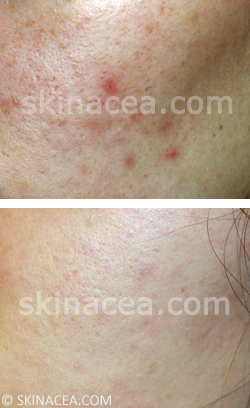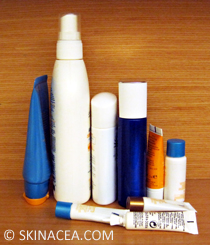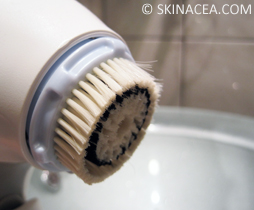How to Fade Post-Acne Red Marks, Dark Spots, Pigmentation, Etc.
Learn how to fade dark marks from your skin |

Fading dark acne marks on my cheek
Post acne marks, or macules, are commonly referred to as “acne scars." Real acne scars, however, are the indentations or protrusions left behind by acne. Acne marks, on the other hand, are the flat red or brown dots left behind by pimples. They are also a type of post-inflammatory hyperpigmentation.
NOTE: Treatment for acne macules is different from treatment for acne scars. We will be covering post-acne marks and post-inflammatory hyperpigmentation (PIH) here. To learn more about acne scars and their treatment options, check out this very informative site.
Acne isn't the only thing that can cause discolored skin marks. Other dark spots and types of skin hyperpigmentation can come from aging, sun damage, and even using birth control pills.
Most of the time, acne marks and dark marks that you get from skin wounds will go away on their own. However, for some people, it can take anywhere from six months to many years for them to lighten completely. Other forms of hyperpigmentation (ones from aging, allergies, etc.) don't fade on their own and may even get darker as time goes on.
To treat these red marks and pigmentation issues, consider the following options:
Sunscreen
 Wearing sunscreen is essential, whether you are trying to fade marks or have no marks to fade whatsoever. It should be a part of your skin care routine because it protects your skin against the sun's harmful UV rays and prevents cancerous lesions.
Wearing sunscreen is essential, whether you are trying to fade marks or have no marks to fade whatsoever. It should be a part of your skin care routine because it protects your skin against the sun's harmful UV rays and prevents cancerous lesions.
If you want to speed up the fading of your hyperpigmentation, it is extra important to use sunscreen consistently. Sunscreen not only prevents sun damage, it helps prevent existing acne macules and other dark spots from getting even darker.Exfoliation
Exfoliating helps fade your acne marks faster by shedding old skin and bringing new skin to the surface. There are lots of options for exfoliation, such as scrubs and washcloths. I personally prefer chemical exfoliation because I feel it penetrates deeper, works faster, and is less physically irritating than manual exfoliation.
 To get rid of red acne marks or hyperpigmentation, you can also consider using prescription retinoids, like Differin, Retin-A, or Tazorac. Prescription azelaic acid, like Finacea, is also known for lightening skin. On the other hand, if you don’t want to use prescription products, you can try over-the-counter products with AHAs as the active ingredient. (I've had good results with using an AHA serum to fade old acne marks.)
To get rid of red acne marks or hyperpigmentation, you can also consider using prescription retinoids, like Differin, Retin-A, or Tazorac. Prescription azelaic acid, like Finacea, is also known for lightening skin. On the other hand, if you don’t want to use prescription products, you can try over-the-counter products with AHAs as the active ingredient. (I've had good results with using an AHA serum to fade old acne marks.)
Though exfoliation is one way to fade dark marks faster, be aware that these types of topical exfoliating products and treatments can cause irritation such as redness, peeling, and dryness. They can also make your skin more sensitive to sunlight, which makes wearing a good sunscreen that much more important.Skin Lighteners
Aside from exfoliating to help skin renew itself faster, you can attack dark spots with skin lighteners such as kojic acid, licorice extract, arbutin, mulberry extract, and vitamin C.
 Hydroquinone is also a skin lightener. However, because there are cancerous risks associated with this ingredient, it has been banned in Europe and Asia. Over-the-counter hydroquinone products are still available in the US market, but anything over 2% requires a doctor's prescription.
Hydroquinone is also a skin lightener. However, because there are cancerous risks associated with this ingredient, it has been banned in Europe and Asia. Over-the-counter hydroquinone products are still available in the US market, but anything over 2% requires a doctor's prescription.
Many Asian skin care products target the lightening and whitening of skin as well. However, before purchasing any of these products, make sure to check the ingredients to see if there are actually effective skin lighteners in the product.
Some people recommend applying vitamin E (either a vitamin E product, 100% vitamin E oil, or vitamin E poked from a gel capsule) on dark marks but in my experience, vitamin E oil can be very irritating when used on its own. In the past, I thought vitamin E would help with scars, marks, and overall healing, so I slathered it all over my face, only to wake up the next morning to lots of tiny red bumps. It took 2 days of cortisone cream to calm my skin down. So, just keep in mind that while vitamin E oil is healing, it can also cause irritation for some people!
When should you treat dark marks?
The fresher the post-acne mark, the brighter color red it will be. Acne macules usually go from bright red to a dark brownish color before fading completely. The earlier you use treatments (i.e. exfoliation, retinoids, AHAs, etc.) to fade marks, the better results you will have. However, you shouldn't use treatment products too early either.
The best time to start using active treatments on dark marks is when the marks are no longer an open injury. If the post-acne mark still looks moist or has a scab, wait for it to dry up and for the scab to fall off on its own before you start any dark mark fading treatments. Exfoliating or using an aggressive treatment while your skin is still repairing itself will only prolong the healing process.
Think about it this way: if you had a cut on your arm and you wanted the cut to go away faster, you wouldn't apply an acid (like an AHA) to the cut. Applying an acid would probably re-injure your skin and keep it red longer. The same line of thinking applies to any injuries (post-acne spots or not) on your face. While your skin is still red and raw, use healing products to speed up its recovery. Once some of the bright red fades from the acne mark, you can then start using an exfoliating treatment.
How long does it take for dark marks to fade?
Exfoliating or using topical products helps shorten the amount of time it takes for red marks to fade, but any product you use will still take time to work. Even if you are exfoliating every day or using the right products, dark marks won't fade immediately. Everyone's skin is different, but with consistent and long term use, you should see results in around two to three months. Depending on how fresh your acne marks are and how fast your skin naturally heals, you may even see results sooner.
While your marks are fading, you may notice some dry skin flakes around the mark or even a dead layer of skin forming over the mark. If this happens, do not pick it off. Let your skin shed on its own when it's good and ready - it's all part of the process of your skin healing itself and you don't want to disrupt it or you'll just make it take longer for your skin to recover. The good news is, most post-acne marks will fade with time. You just have to be patient!
However, if you are really impatient, you can opt for facial procedures such as chemical peels, lasers, and/or microdermabrasion for faster results. Facial procedures do not perform miracles either because they also take at least two to three treatment sessions spaced several months apart for you to start seeing your desired results.
Good things come with time
If you want a quick fix for any dark spots, a good concealer will do the trick. Otherwise, the best way to fade acne marks is to: 1) prevent the marks from getting darker by wearing a good sunscreen, 2) help your skin's renewal process by using exfoliators or skin lighteners, and 3) be patient!
Last updated: May 7, 2013
Back « How To's
Related articles:
- My Glycolic Peel Experience
- Wear Sunscreen the Right Way
- Types of Retinoids
- Four Golden Rules for Beautiful Skin
- DIY Recipe: Homemade Vitamin C Serum
